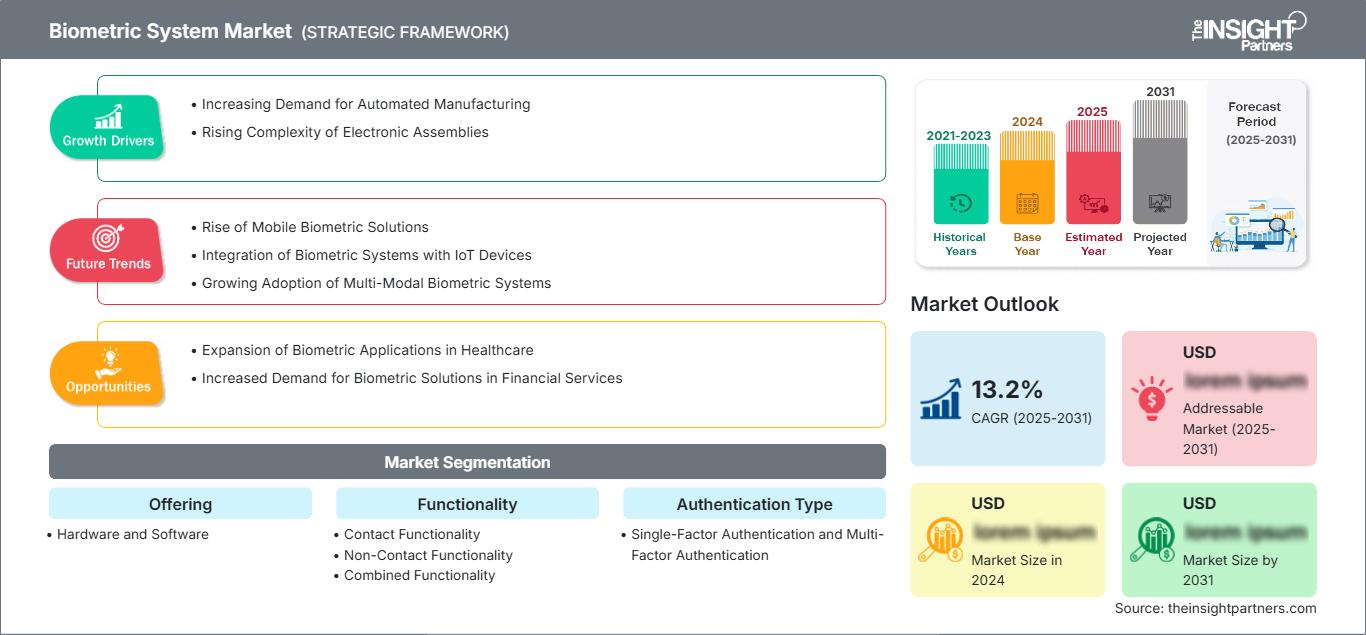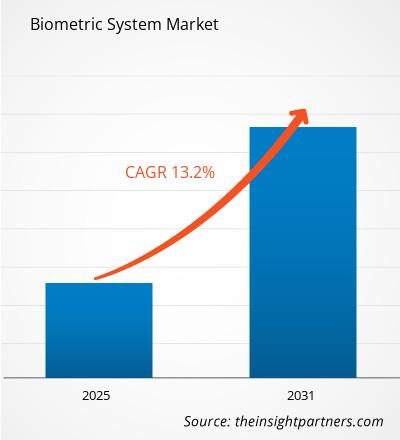Si prevede che il mercato dei sistemi biometrici registrerà un CAGR del 13,2% dal 2025 al 2031, con una dimensione del mercato in espansione da XX milioni di dollari nel 2024 a XX milioni di dollari entro il 2031.
Il rapporto è segmentato per offerta (hardware e software), funzionalità (funzionalità di contatto, funzionalità senza contatto e funzionalità combinata), tipo di autenticazione (autenticazione a fattore singolo e autenticazione a più fattori), utente finale (BFSI, governo, militare e difesa, elettronica di consumo, sanità, automotive e altri). L'analisi globale è ulteriormente suddivisa a livello regionale e per i principali paesi. Il rapporto offre il valore in USD per l'analisi e i segmenti sopra indicati.
Scopo del rapporto
Il rapporto "Biometric System Market" di The Insight Partners mira a descrivere il panorama attuale e la crescita futura, i principali fattori trainanti, le sfide e le opportunità. Ciò fornirà spunti a vari stakeholder aziendali, come:
- Fornitori/produttori di tecnologia: per comprendere le dinamiche di mercato in evoluzione e conoscere le potenziali opportunità di crescita, consentendo loro di prendere decisioni strategiche informate.
- Investitori: per condurre un'analisi completa delle tendenze in merito al tasso di crescita del mercato, alle proiezioni finanziarie del mercato e alle opportunità esistenti lungo la catena del valore.
- Organismi di regolamentazione: per regolamentare le politiche e le attività di controllo nel mercato con l'obiettivo di ridurre al minimo gli abusi, preservare la fiducia degli investitori e sostenere l'integrità e la stabilità del mercato.
Offerta di segmentazione del mercato dei sistemi biometrici
- Hardware e software
Funzionalità
- Funzionalità di contatto
- Funzionalità senza contatto
- Funzionalità combinata
Tipo di autenticazione
- Autenticazione a fattore singolo e autenticazione a più fattori
Utente finale
- BFSI
- Governo
- Militare e difesa
- Elettronica di consumo
- Sanità
- Automotive
Potrai personalizzare gratuitamente qualsiasi rapporto, comprese parti di questo rapporto, o analisi a livello di paese, pacchetto dati Excel, oltre a usufruire di grandi offerte e sconti per start-up e università
Mercato dei sistemi biometrici: Approfondimenti strategici

- Ottieni le principali tendenze chiave del mercato di questo rapporto.Questo campione GRATUITO includerà l'analisi dei dati, che vanno dalle tendenze di mercato alle stime e alle previsioni.
Fattori di crescita del mercato dei sistemi biometrici
- Crescente domanda di produzione automatizzata: il passaggio all'automazione nei processi produttivi è un fattore chiave per il mercato delle macchine per l'inserimento di pin. Le macchine per l'inserimento di pin semplificano il processo di assemblaggio, migliorando la velocità di produzione, la precisione e riducendo i costi di manodopera. Settori come l'elettronica, l'automotive e la produzione industriale richiedono un posizionamento efficiente e accurato dei componenti, rendendo le macchine per l'inserimento di pin automatizzate fondamentali per migliorare la produttività complessiva e la coerenza nelle linee di assemblaggio.
- Crescente complessità degli assemblaggi elettronici: con la crescente compattezza e complessità dei componenti elettronici, cresce la necessità di soluzioni di assemblaggio precise come le macchine per l'inserimento di pin. I dispositivi elettronici moderni richiedono connessioni affidabili e precise dei componenti e le macchine per l'inserimento di pin sono essenziali per soddisfare queste esigenze. La crescente complessità delle schede elettroniche e dei connettori in diversi settori sta alimentando l'adozione della tecnologia di inserimento dei pin.
Trend futuri del mercato dei sistemi biometrici
- Ascesa delle soluzioni biometriche mobili: la tendenza verso le soluzioni biometriche mobili sta prendendo piede poiché smartphone e dispositivi indossabili integrano sempre più funzionalità di autenticazione biometrica. Scanner di impronte digitali, riconoscimento facciale e riconoscimento vocale sono ormai standard in molti dispositivi mobili, rendendo più facile per gli utenti accedere alle proprie applicazioni in modo sicuro. Questa tendenza non solo sta migliorando la praticità d'uso, ma sta anche guidando l'adozione di sistemi biometrici in vari settori, come quello bancario, dell'e-commerce e dell'assistenza sanitaria, dove l'accesso mobile sta diventando essenziale.
- Integrazione dei sistemi biometrici con i dispositivi IoT: l'integrazione dei sistemi biometrici con l'Internet of Things (IoT) sta emergendo come una tendenza significativa. Con l'interconnessione di un numero sempre maggiore di dispositivi, cresce la necessità di metodi di autenticazione sicuri. I sistemi biometrici possono migliorare la sicurezza dei dispositivi IoT fornendo l'autenticazione utente per sistemi di smart home, applicazioni industriali e veicoli connessi. Si prevede che questa integrazione stimolerà la domanda di soluzioni biometriche, poiché gli utenti desiderano garantire che i loro ambienti interconnessi siano protetti da accessi non autorizzati.
- Crescente adozione di sistemi biometrici multimodali: si registra una tendenza evidente verso l'adozione di sistemi biometrici multimodali, che combinano due o più caratteristiche biometriche per l'autenticazione. Integrando metodi diversi, come la scansione delle impronte digitali con il riconoscimento facciale, questi sistemi offrono maggiore accuratezza e sicurezza. Questa tendenza è particolarmente importante negli ambienti ad alta sicurezza, dove un singolo metodo potrebbe non essere sufficiente. Il crescente riconoscimento dei vantaggi dei sistemi multimodali sta spingendo le organizzazioni a investire in soluzioni biometriche più sofisticate.
Opportunità di mercato per i sistemi biometrici
- Espansione delle applicazioni biometriche in ambito sanitario: il settore sanitario offre significative opportunità per i sistemi biometrici, in particolare nell'identificazione dei pazienti e nel controllo degli accessi. L'autenticazione biometrica può semplificare i processi di registrazione dei pazienti, ridurre il rischio di furto di identità medica e garantire un accesso sicuro alle cartelle cliniche. Poiché le strutture sanitarie mirano a migliorare la sicurezza dei pazienti e l'efficienza operativa, si prevede che l'implementazione di sistemi biometrici per l'accesso sicuro e la verifica dell'identità crescerà, creando una redditizia opportunità di mercato.
- Crescita della domanda di soluzioni biometriche nei servizi finanziari: il settore dei servizi finanziari sta riconoscendo sempre più la necessità di misure di sicurezza avanzate per proteggere le informazioni sensibili dei clienti e prevenire le frodi. Metodi di autenticazione biometrica, come il riconoscimento vocale e la scansione delle impronte digitali, vengono integrati nelle applicazioni bancarie e nei sistemi di pagamento per migliorare la sicurezza e l'esperienza del cliente. Questa crescente domanda di soluzioni biometriche nelle transazioni finanziarie rappresenta una preziosa opportunità per i fornitori di tecnologia di sviluppare soluzioni innovative su misura per le esigenze di questo settore.
Mercato dei sistemi biometrici
Le tendenze regionali e i fattori che influenzano il mercato dei sistemi biometrici durante il periodo di previsione sono stati ampiamente spiegati dagli analisti di The Insight Partners. Questa sezione illustra anche i segmenti e la geografia del mercato dei sistemi biometrici in Nord America, Europa, Asia-Pacifico, Medio Oriente e Africa, America Meridionale e Centrale.
Ambito del rapporto di mercato sui sistemi biometrici
| Attributo del rapporto | Dettagli |
|---|---|
| Dimensioni del mercato in 2024 | US$ XX million |
| Dimensioni del mercato per 2031 | US$ XX Million |
| CAGR globale (2025 - 2031) | 13.2% |
| Dati storici | 2021-2023 |
| Periodo di previsione | 2025-2031 |
| Segmenti coperti |
By Offerta
|
| Regioni e paesi coperti | Nord America
|
| Leader di mercato e profili aziendali chiave |
|
Densità degli attori del mercato dei sistemi biometrici: comprendere il suo impatto sulle dinamiche aziendali
Il mercato dei sistemi biometrici è in rapida crescita, trainato dalla crescente domanda degli utenti finali, dovuta a fattori quali l'evoluzione delle preferenze dei consumatori, i progressi tecnologici e una maggiore consapevolezza dei vantaggi del prodotto. Con l'aumento della domanda, le aziende stanno ampliando la propria offerta, innovando per soddisfare le esigenze dei consumatori e sfruttando le tendenze emergenti, alimentando ulteriormente la crescita del mercato.

- Ottieni il Mercato dei sistemi biometrici Panoramica dei principali attori chiave
Punti di forza
- Copertura completa: il rapporto analizza in modo esaustivo prodotti, servizi, tipologie e utenti finali del mercato dei sistemi biometrici, offrendo una panoramica olistica.
- Analisi degli esperti: il rapporto è redatto sulla base della conoscenza approfondita di esperti e analisti del settore.
- Informazioni aggiornate: il rapporto garantisce la pertinenza aziendale grazie alla copertura di informazioni e tendenze dei dati recenti.
- Opzioni di personalizzazione: questo rapporto può essere personalizzato per soddisfare le esigenze specifiche del cliente e adattarsi in modo appropriato alle strategie aziendali.
Il rapporto di ricerca sul mercato dei sistemi biometrici può quindi contribuire a guidare il percorso di decodificazione e comprensione dello scenario del settore e delle prospettive di crescita. Sebbene possano esserci alcune valide preoccupazioni, i vantaggi complessivi di questo rapporto tendono a superare gli svantaggi.
- Analisi storica (2 anni), anno base, previsione (7 anni) con CAGR
- Analisi PEST e SWOT
- Valore/volume delle dimensioni del mercato - Globale, Regionale, Nazionale
- Industria e panorama competitivo
- Set di dati Excel
Report recenti
Rapporti correlati
Testimonianze
Motivo dell'acquisto
- Processo decisionale informato
- Comprensione delle dinamiche di mercato
- Analisi competitiva
- Analisi dei clienti
- Previsioni di mercato
- Mitigazione del rischio
- Pianificazione strategica
- Giustificazione degli investimenti
- Identificazione dei mercati emergenti
- Miglioramento delle strategie di marketing
- Aumento dell'efficienza operativa
- Allineamento alle tendenze normative




















 Ottieni un campione gratuito per - Mercato dei sistemi biometrici
Ottieni un campione gratuito per - Mercato dei sistemi biometrici